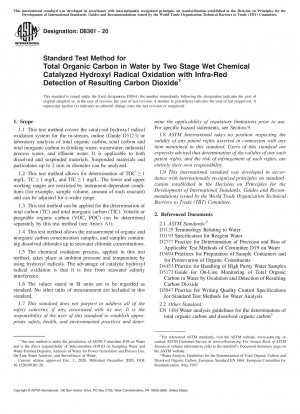ASTM D8361-20
Standard Test Method for Total Organic Carbon in Water by Two Stage Wet Chemical Catalyzed Hydroxyl Radical Oxidation with Infra-Red Detection of Resulting Carbon Dioxide
- Standard No.
- ASTM D8361-20
- Release Date
- 2020
- Published By
- American Society for Testing and Materials (ASTM)
- Latest
- ASTM D8361-20
- Scope
- 1.1 This test method covers the catalyzed hydroxyl radical oxidation system for the in-stream, online (Guide D5173) or laboratory analysis of total organic carbon, total carbon and total inorganic carbon in drinking water, wastewater, industrial process water, and effluent water. It is applicable to both dissolved and suspended materials. Suspended materials and particulates up to 2 mm in diameter can be analyzed. 1.2 This test method allows for determination of TOC ≥ 1 mg/L, TC ≥ 1 mg/L, and TIC ≥ 1 mg/L. The lower and upper working ranges are restricted by instrument-dependent conditions (for example, sample volume, amount of each reactant) and can be adjusted for a wider range. 1.3 This test method can be applied for the determination of total carbon (TC) and total inorganic carbon (TIC). Volatile or purgeable organic carbon (VOC, POC) can be determined separately by this test method (see Annex A1). 1.4 This test method allows the measurement of organic and inorganic carbon concentration samples, and samples containing dissolved chlorides up to seawater chloride concentrations. 1.5 The chemical oxidation process, applied in this test method, takes place at ambient pressure and temperature by using hydroxyl radicals. The advantage of catalytic hydroxyl radical oxidation is that it is free from seawater salinity interference. 1.6 The values stated in SI units are to be regarded as standard. No other units of measurement are included in this standard. 1.7 This standard does not purport to address all of the safety concerns, if any, associated with its use. It is the responsibility of the user of this standard to establish appropriate safety, health, and environmental practices and determine the applicability of regulatory limitations prior to use. For specific hazard statements, see Section 9. 1.8 ASTM International takes no position respecting the validity of any patent rights asserted in connection with any item mentioned in this standard. Users of this standard are expressly advised that determination of the validity of any such patent rights, and the risk of infringement of such rights, are entirely their own responsibility. 1.9 This international standard was developed in accordance with internationally recognized principles on standardization established in the Decision on Principles for the Development of International Standards, Guides and Recommendations issued by the World Trade Organization Technical Barriers to Trade (TBT) Committee.
ASTM D8361-20 Referenced Document
- ASTM D1129 Standard Terminology Relating to Water
- ASTM D1193 Standard Specification for Reagent Water
- ASTM D2777 Standard Practice for Determination of Precision and Bias of Applicable Methods of Committee D-19 on Water
- ASTM D3694 Standard Practices for Preparation of Sample Containers and for Preservation of Organic Constituents
- ASTM D4453 Standard Practice for Handling of Ultra-Pure Water Samples
- ASTM D5173 Standard Test Method for On-Line Monitoring of Carbon Compounds in Water by Chemical Oxidation, by UV Light Oxidation, by Both, or by High Temperature Combustion Followed by Gas Phase NDIR or by Electrolytic Conductivity
- ASTM D5847 Standard Practice for Writing Quality Control Specifications for Standard Test Methods for Water Analysis
ASTM D8361-20 history
- 2020 ASTM D8361-20 Standard Test Method for Total Organic Carbon in Water by Two Stage Wet Chemical Catalyzed Hydroxyl Radical Oxidation with Infra-Red Detection of Resulting Carbon Dioxide
